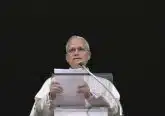In final weeks of campaign season, politicos buying up local TV ad time
By Mark Pattison, Catholic News Service
WASHINGTON — In the wake of the Republicans’ and Democrats’ national conventions bookending the Labor Day holiday, it seemed as if each campaign asked questions that ended with the words “better off.”
Are you better off as an individual? As a family? Are we better off as a country? Heck, it was even asked whether Osama bin Laden is better off now than he was four years ago.
However, when it comes to campaign advertising, the response should very well be: “Better off.”
In the last weeks of the campaign season, the inventory of available TV advertising airtime has just about dried up, particularly in the swing states.
And if you live in a state with a hotly contested race but few stations, the campaigns have to turn to more expensive markets to get their message out, such as New York for northern New Jersey, Philadelphia for Delaware and southern New Jersey, Boston for New Hampshire, and Washington for northern Virginia.
Then again, with no caps on campaign contributions because of the Supreme Court’s ruling in the Citizens United case a couple of years ago, cost doesn’t seem to be an issue, not when donors are willing to write seven- and eight-figure checks to promote their preferred candidate.
Fact-checkers have found errors, truth-stretching and outright falsehoods aplenty in ads, but campaigns don’t seem inclined to pull or rework the ads, and the TV stations, playing their own version of don’t ask, don’t tell, are keeping mum.
One estimate had it that if you watched every campaign ad purchased in the United States for the two months prior to the Nov. 6 election, you’d be watching TV for six months straight, day and night.
While there’s a new phenomenon in the TV world called binge viewing — watching an entire season’s worth of shows, or even a complete series — in chronological order, the glut of political ads makes such binge viewing pale by comparison. Watching all eight seasons of “24” back to back, for instance, would take you about five-and-a-half days — child’s play compared to the surfeit of political ads.
Twenty years ago, you could argue that the “giant sucking sound” independent presidential candidate H. Ross Perot spoke about could have meant the inhaling of campaign cash by TV stations and networks. Back then, Perot was buying 30-minute chunks of time on network prime time to make his case before the American electorate. These days, you’re lucky if you see a political ad that lasts longer than 30 seconds.
But if you watch enough of them, you may happen upon a “long-form” political ad. Go to Denver, the biggest city in hotly contested Colorado, where the four biggest TV stations have collected nearly $20 million in revenues from political ad time buys, according to the Television Bureau for Advertising.
Denver, however, isn’t even in the top five of TV markets when it comes to campaign cash buying ad time.
TV stations in Orlando, Fla., raked in $24.85 million, making it fifth. Las Vegas’ TV outlets are collecting at $30.67 million, but that’s just a fourth-place finish. Another Florida market, Tampa-St. Petersburg, has $31.23 million in ad billings, giving it the bronze medal. Coming in second is Washington — including vote-rich northern Virginia — with its stations’ coffers pumped up to the tune of $35.50 million.
But the champion is Cleveland, whose TV stations racked up $37.25 million in political ad buys. And small wonder: It has been a tossup state for most of the elongated campaign, and no Republican has ever won the White House without winning Ohio.
Looked at another way, nearly 22 percent of all local advertising on Sioux City, Iowa, TV is political.
In contrast, populous Illinois is pretty much ignored. Because it’s considered a safe state for President Barack Obama, the ad buyers are taking their dollars to TV stations in states they think will make a difference.
According to an analysis by Wells Fargo, 45.7 percent of the political spending on local TV is for the presidential race, 33 percent for congressional races, 17.5 percent for ballot measures and 3.8 percent for local races. The analysis noted $3.37 billion in TV political ad spending, resulting in an average 23 percent revenue increase for TV stations over 2011.
So, if you think you’re seeing more political ads than ever before, you’re probably right. At least now you know why.
Pattison is media editor for Catholic News Service.













